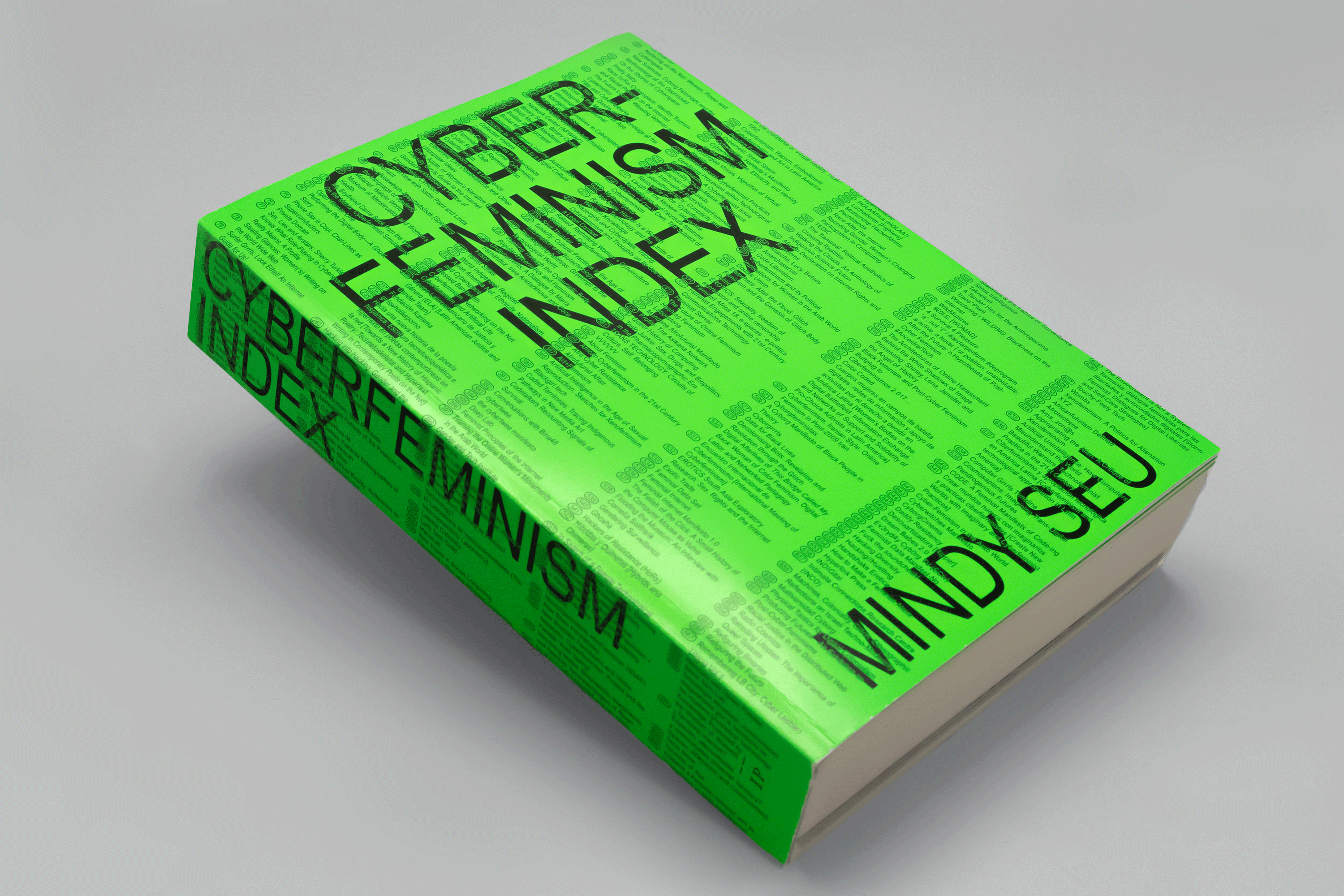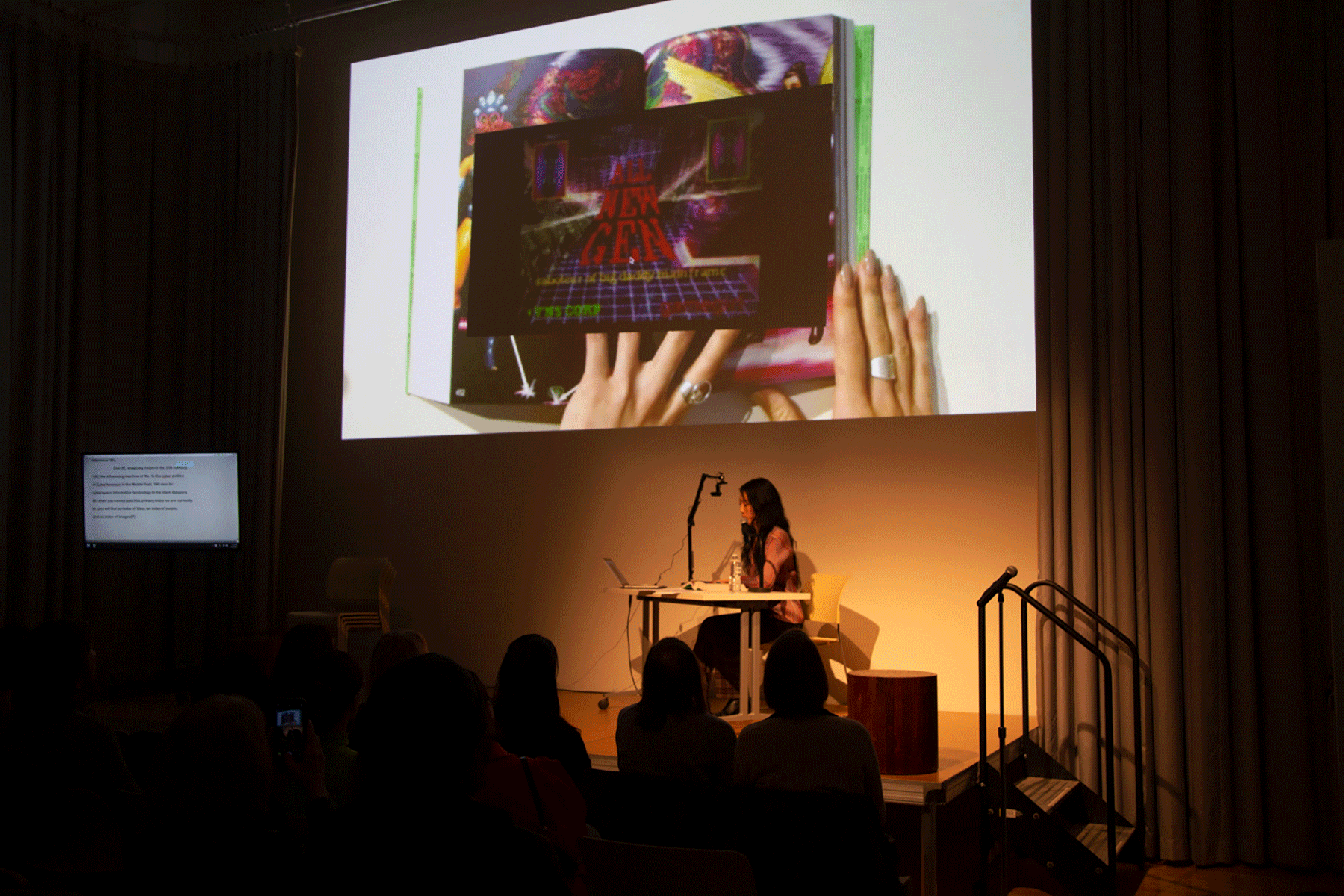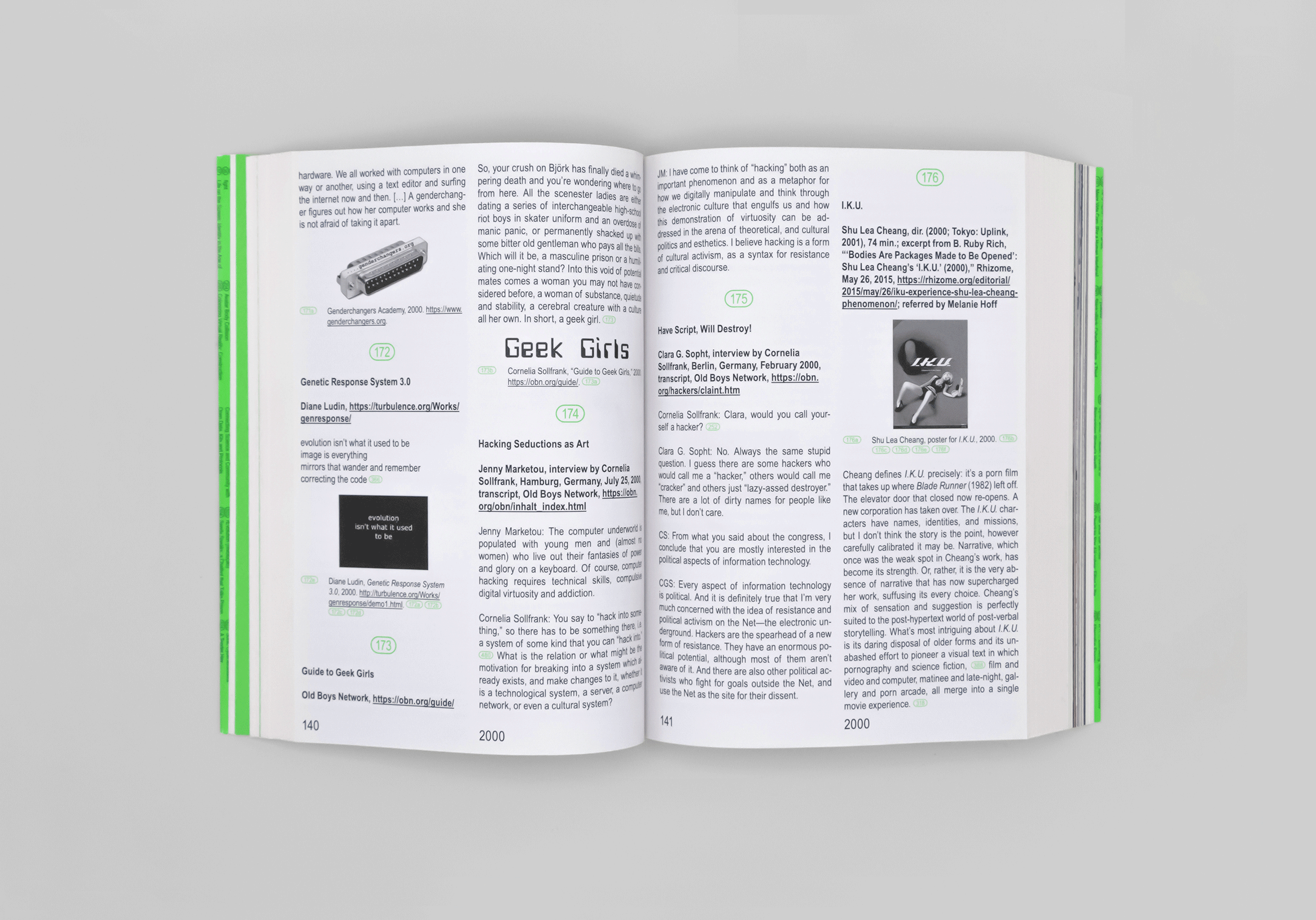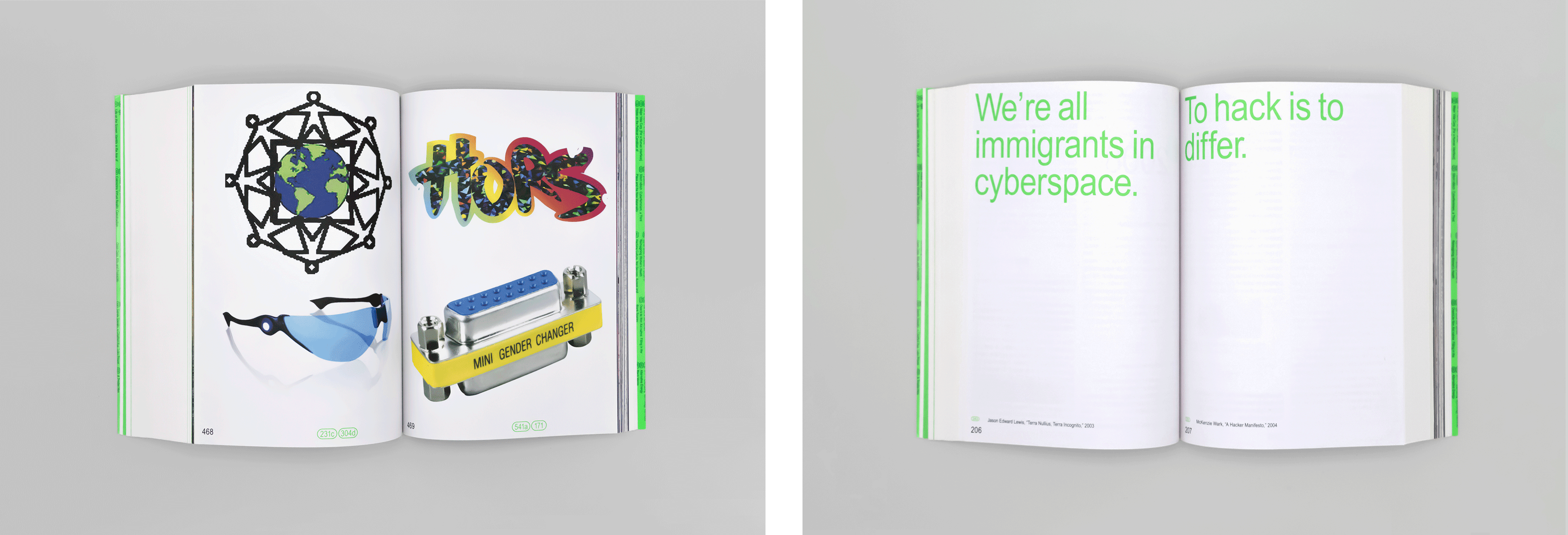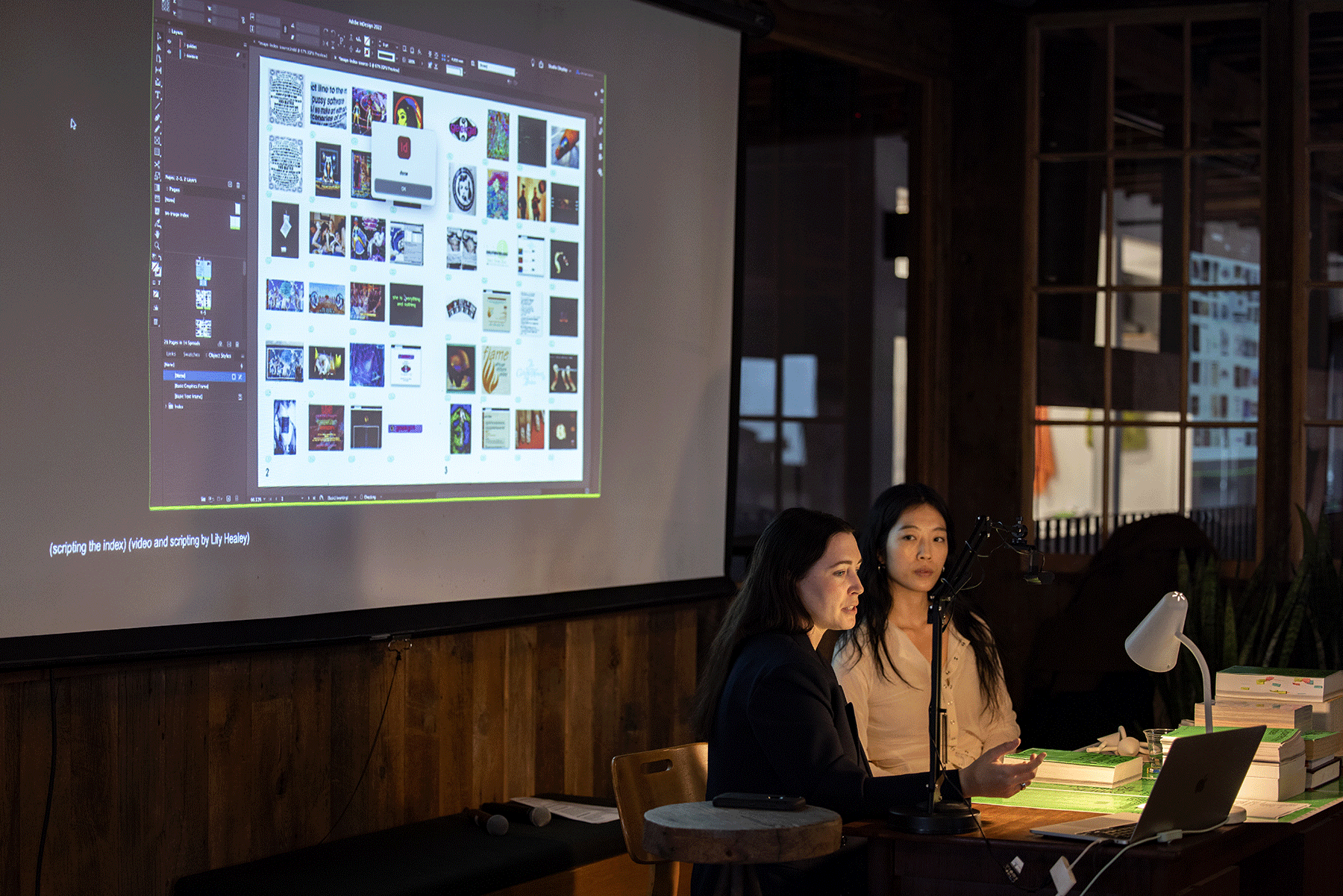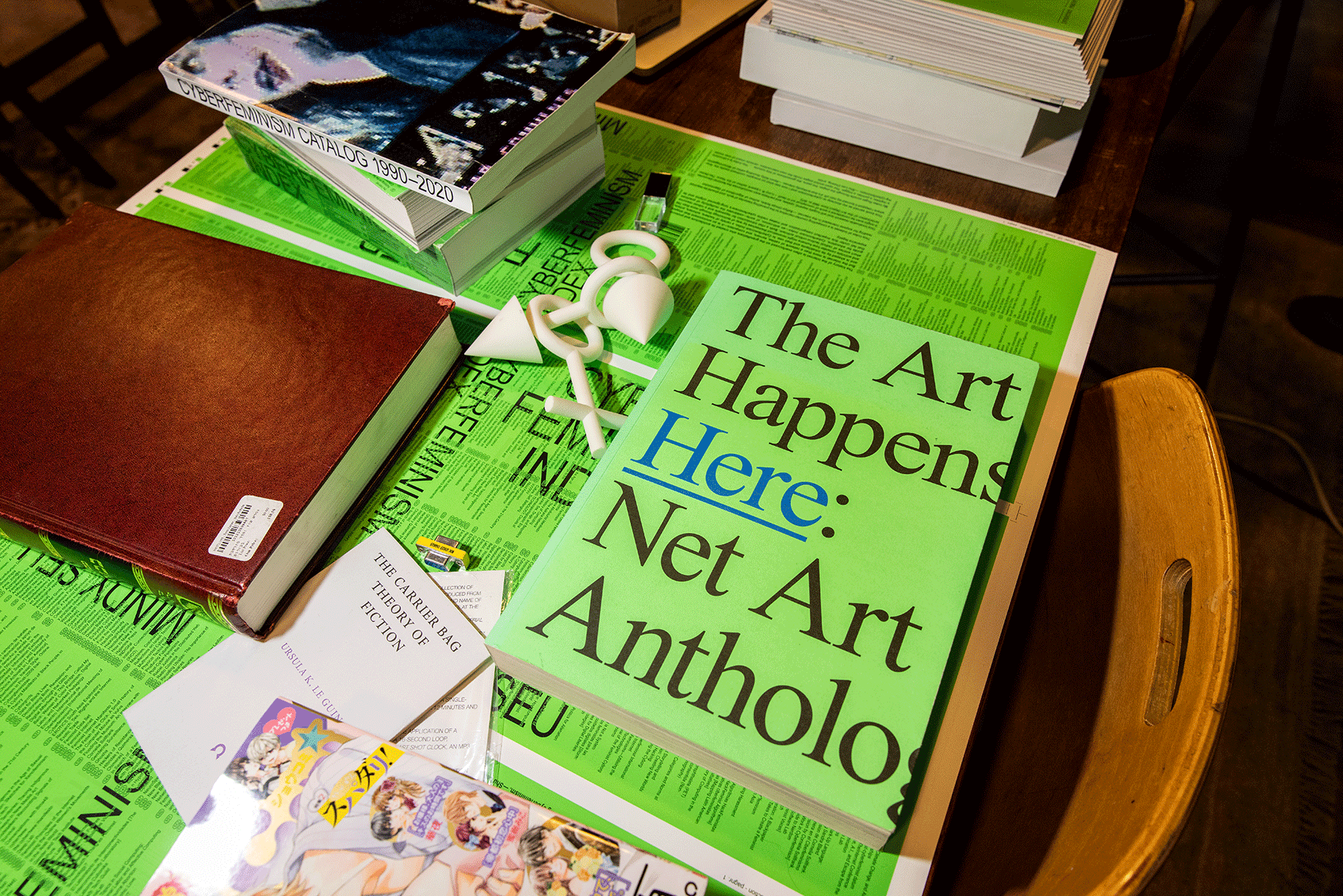Introduction
Leslie Atzmon: Can you tell me a little about yourselves?
Mindy Seu: I’m currently an Assistant Professor of [Art and Design] at Rutgers University and I also teach at Yale University. My practice feels quite multi-hyphenate—not only do I work on design commissions—I’m also teaching, creating lecture-performance, curating, and writing… always in collaboration. I describe myself as medium-agnostic, and I typically fall into bodies of research and let that inform that final output.
Laura Coombs: I am a graphic designer in New York City. I am Head of Design at the New Museum of Contemporary Art and work frequently with its technology incubator NEW INC [https://www.newinc.org/] and its affiliate net art organization Rhizome [https://rhizome.org/]; I lead an eponymous studio designing visual identities, websites, and publications for artists, architects, and cultural organizations and institutions; I am a Lecturer in graphic design at Princeton [https://arts.princeton.edu/]. My practice moves between my own studio, the museum, lecturing, and teaching in a fluid way, and, like Mindy, I am always collaborating. Before becoming a graphic designer, I grew up in a small town in north Texas, studied architecture at Cornell University, and spent some time in New York City working on architectural projects—building complex material geometries with intricate fabrication technologies—before studying graphic design under Sheila Levrant de Bretteville at the Yale School of Art [https://www.art.yale.edu/].
LA: Mindy, do you teach design across disciplines and media as well, or mainly communication/graphic design?
MS: At the undergraduate level, I primarily lead design studios, while my graduate classes feel like R&D for my own research, from lecture performances, archival criticism, and network culture, among others.
LA: Mindy, can you briefly tell me a bit about your other work: performance, curating, writing, etc.?
MS: I’ve become tired of Keynotes and Powerpoints, so I began thinking of alternative ways of presenting, from browser-based lectures (inspired by artist Emma Rae Bruml) about internet history and the metaverse, to those using the book-as-interface with Augmented Reality, built by artist Tommy Martinez. It’s a way to demonstrate new media while discussing new media. I love feedback loops. All of these talks serve as fodder for essays, like “The Metaverse is a Contested Territory” for Pioneer Works, c “The Internet Exists on Planet Earth” for Source Type, d and the “Poetry of Tools” for the first Are.na Annual. e Lectures feel like a way to publicly workshop these ideas, and I’m very open about process and in-progress work. My curatorial projects are about the anthropocene and slimy interfaces, like the Scalability Project with Roxana Fabius and Patricia M. Hernandez for A.I.R. Gallery and Wetware for Feral File, respectively.
LA: How did you two meet, and how did you decide to work on this project together? Did Laura work on the site as well, or just the book?
MS: I was familiar with Laura’s work before we first met at a panel at Pratt Institute organized by Other Means f in 2019. Our first date was at a Thai restaurant in Nolita, and we’ve been fast friends ever since.
LC: We indeed met on a panel at Pratt Institute and shared a taxi afterwards. By the time we reached our destinations, we planned the lunch at Lovely Day, g and we were already friends.
Actually, I did help in a tiny way with the site cyberfeminismindex.com. I contributed a typeface we nicknamed “Arial Symbol” that automatically creates the encircled numbers or cross references you see on the site when a special syntax is used in html. When a number enclosed in parentheses, ex. (700), appears in html, it calls the encircled 700 glyph from the typeface.
LA: Just briefly, for both of you, how do you feel that collaboration enhances what you do?
MS: Collaboration and discourse are essential for my practice—they feel generative. I find collaboration to be a much faster and more energizing way of working.
LC: I believe collaboration has allowed me to grow the most as a designer—I have been lucky to work with brilliant designers like Mindy, and although I love working alone as well, my collaborators have shaped my thinking and my work in unexpected and generative ways that I would have missed without them. I always joke that I can collaborate with anyone—this is true, but it’s also a continuous life goal that coincides with wanting to be a lifelong learner and to stay curious about how my design practice can evolve unexpectedly.
THE CYBERFEMINISM INDEX PROJECT
LA: Can you please describe the project Cyberfeminism Index?
MS: The Cyberfeminism Index is an umbrella project with multiple containers… first a spreadsheet to a website, then a book activated through performative Augmented Reality readings. It’s constantly mutating and expanding, like a living index.
FIGURE 1: The Cyberfeminism Index book. Image courtesy of Inventory Press. h Image by Inventory Press.
LA: Can you discuss the structure of the project and how it evolved/es in more detail?
MS: I started a bibliography-as-spreadsheet in grad school because I was trying to compile resources of theory and practice related to creative and critical uses of technology. So many of my peers were engaged in this space and I wondered why there wasn’t an aggregator of these important works. I didn’t know where it would lead—it was only meant as a tool for myself. But once I put it online, asking for feedback and additional examples, it snowballed from there and transformed into a collective, crowd-sourced and open-source index. I scraped bibliographies compiled by others, talked to peers who referred me to others, and this spiderwebbed into the foundation of the project. Then, in 2020, Rhizome i commissioned this as a website, and I was able to work with friends to build out the project. Angeline Meitzler, an artist and programmer, developed an online database where people could submit entries. We also worked with programmer Janine Rosen for additional frontend support and then Charles Broskoski, co-founder of Are.na, for the PDF generator, since all readers are able to export their selections as a PDF file. Paul Soulellis, a RISD Professor and the creator of Queer.Archive.Work, j once wrote that downloading is a political act, especially in a time when we no longer own our content. This was an important premise, because it allowed people to create different snapshots of the website at specific moments in time.
During the pandemic, I focused on creating a snapshot of this website as a draft manuscript. With the help of several grants from the Graham Foundation, the Pratt Institute, and Rutgers University, among others, we were then able to segue into over a year of editing and designing. Even after this, when the book was published by Inventory Press, we ran into the cursed post-COVID supply chain and the book release, which was originally set for November 2022, was pushed to January 2023.
LA: What role does augmented reality play in the structure and function of the site and book?
MS: The book as interface… of course books are already interactive, but Augmented Reality allowed us to show the liveness of the images. I worked with Tommy Martinez to create a bespoke app that could be used for the performative readings, overlaying videos of the net artworks and websites atop their respective static images in the book.
FIGURE 2: Mindy Seu gives a performative reading of the Cyberfeminism Index at the New Museum (New York, NY, USA) at its book launch on November 14, 2022. A video of All New Gen by VNS Matrix k is overlaid atop the respective book spread using an AR app created by Tommy Martinez. (VNS Matrix was an artists’ collective based in Adelaide, Australia that was formed in 1991. They are among the first artists known to have used the term cyberfeminism to describe their work and their approaches to creating it.) Image courtesy of Mindy Seu. Image by Shina Peng.
CYBERFEMINISM AND INDEXING
LA: What is cyberfeminism?
LC: Funny, we have an image in the colophon that asks that very question, “What is cyberfeminism?”
MS: Yes! The “What is cyberfeminism?” artifact appeared on artist Helene von Oldenberg’s page on the Old Boys Network website. The Old Boys Network was a cyberfeminist alliance founded in Berlin and active from around 1997–2001. Von Oldenberg asked the public for their thoughts about cyberfeminism, and the question was met with a lot of confusion. Ultimately, the term shifts by region, by person, truly embracing a constantly mutating definition. The simplest way to describe this would be the critical use of technology, often in the form of net art and online activism.
LA: Helene von Oldenberg’s page on the Old Boys Network website is one of the entries in the index?
MS: Her page is seen in the video of the Old Boys Network displayed through AR.
LC: The Old Boys Network appears frequently in Cyberfeminism Index. This image—catalogued as image 102d—is tied to entry 102 in the book.
LA: Can you give a couple of examples of the way that people have defined/expressed cyberfeminism; possibly examples you could describe from within the project?
MS: For the exhibition Wetware on Feral File (feralfile.com/exhibitions/wetware-tkl), we asked selected artists in the book to answer this very question.
Artist Shu Lea Cheang focuses on the mutation in her response: “The mutation is the most normal process in our proceedings; the way we perceive the world should always be in mutation. Maybe the next generation of cyberfeminism doesn’t need to be named: neither cyber, neither feminism, but definitely mutating. When you talk about a mutating medium, do you still use the same name? Or do you call it C.F. Variant 10.0?”
Cornelia Sollfrank, a seminal net artist and member of the Old Boys Network, describes cyberfeminism in terms of its expanded children: “Cyberfeminism … was related to these ideas and utopias of the ’90s. Which is why I decided to work with a different term: technofeminism. Cyberfeminism is associated with specific things that were very strong, very extreme, and very anarchic. So we can’t pretend that we are in the same state we were in 20 years ago. I try to elaborate with technofeminism how … it has evolved. Back then, we reduced cyberfeminism to the technical infrastructure and how it related to our heads. We have since learned so much more… and that we cannot distinguish technology from our environment, or from our bodies.”
LA: Why is it important to make the cyberfeminist information in your project available to people?
MS: Regardless of whether people had ever encountered the word “cyberfeminism,” there is a clear techno dystopian thinking about the internet today. Seeing an aggregate, however subjective, of techno critical works offers an alternative to this. It relays so many examples, across three decades, of hackerspaces, manifestos, syllabi, artworks, activism that suggest how technology is embedded into society, and how different people can affect its use and development. Whenever I’m feeling forlorn about the state of the internet now, the Index feels like a spotlight on the rhizomatic strands of a movement of people truly caring about the relationship between human and machine and attempting to fix these tools.
LA: How would you define the term index?
MS: Unlike an archive, which points inward, an index is essentially a finding aid, pointing outward. It brings together disparate objects in a porous container.
LA: What about indexing? Can you discuss why you chose to address cyberfeminist information in this way versus, say, in an essay?
MS: An index of different voices shows how cacophonous this history truly is—it’s not meant to be a singular objective history, but rather a co-authored collection of multiple subjective histories. Not everyone agrees, not everyone works in the same way, but there is a throughline of a critically assessing technology’s impact on our worlds.
LC: I think we rarely see such an aggregate recording of web activity told mostly through the artists’ own words. The index form is powerful in this regard—it shows more than it tells. The book is also framed with beginning and ending essays, and includes a section called “Collections” that is a compilation of curated walkthroughs or tours of the book by various artists and scholars. In this way, the book is a hybrid of text and index.
LA: Can you please discuss how the indexing works in the project?
LC: The book is organized as a series of lists—of titles or images or names—all organized chronologically and/or alphabetically. Neon green encircled numbers (1–703) act as cross references, connecting entries throughout the book and weaving all the sections together.
MS: The book and website show various hypertextual journeys that readers can take. We tend to think of hyperlinks with a digital connotation, but this concept was inspired by many analog precursors, like cross-references, bibliographies, and footnotes. Entries have some version of a title, author, year, region, external links, and images, and they are connected together through hyperlinks and cross-references with other entries that might complement or juxtapose their content.
THE BOOK AND SITE
LA: You pointed out in a talk you gave recently that the book records a moment in time, whereas the site is evolving. What are the pros and cons of different information media for a project like this?
LC: There is power in this physical material form as an academic citational object that will live in academic and public libraries globally. I’m also reminded of something Sheila Levrant de Bretteville said to me once when I asked why the requirement for the fulfillment of the graphic design thesis at Yale is a physical book: “Books are forever.” A book is a moment in time, but lasts for essentially all time. This everlasting snapshot of the web translated into a book offers new ways of making this content academic—now these 700+ activities on the web can be cited as academic textual references instead of URLs only.
MS: I see the book as a virus in a way… it’s a grassroots effort, but it’s inserted into “legitimizing” institutions, like the Library of Congress, to act as a record of revisionist internet history. The book, then, is meant to live as a snapshot of a moment in the website’s mutation. The website continues to be a living index, crowdsourcing in perpetuity.
LA: How is the information organized on the site? In the book? How do they relate?
MS: Having different containers for the Index has revealed the affordances of each medium. Even if it’s a similar body of content, different aspects are highlighted depending on how you access it. On the website, it’s dynamic, it’s sortable, it’s searchable. In the book, it’s chronological and alphabetical, as an index of indexes, with different entry points shown through highlighted pull quotes, full bleed images, and of course, extensive hyperlinking.
PROJECT DESIGN
LA: What were your design parameters for the site? The book?
MS: For the website, Angeline and I focused on two primary questions. How do websites age? How do we visualize citations? We wanted to make sure the website could last as long as possible. According to Forbes, the average lifespan of a website is a mere 2.5 years. By using HTML “defaults” and avoiding any third-party JavaScript libraries and new scripts, the site became more durable and also happens to adopt the appearance of retro-sites.
LC: The book is a study in economy in a few ways. The book is the maximum “medium” size that fits on a press sheet, creating the least amount of paper waste possible. From there, the bulk of the book is duotone (neon green and black) and printed on an economical, fluffy, recycled newsprint. There are only a couple of signatures printed in 5/5 (CMYK + neon green). We incorporated the neon green into the 4-color images in order to translate the bright colors that appear on screen and on the web into print. Neon green happens to be a color that lives happily on the web, but is impossible to reproduce in print without the materiality of fluorescent ink. I imagined the green as both a practical material, linking all the content together, and also, as a gooey slime, seeping into the images.
The book’s content was transferred from cyberfeminismindex.com to a set of edited Google Docs and spreadsheets. The book design is a set of styles and templates in InDesign. Our colleague, Lily Healey, scripted the Google Docs into InDesign styles, creating a seamless bridge from information to design. The InDesign styles are not so precious in terms of ‘perfect’ typesetting, and were not overly manicured after the scripting process. We embraced clunkiness in typesetting, as another way to express a living index.
The images in the book are all in their native resolution from their original placement on the web. They were each placed into the book design, many of them simply a tiny thumbnail, and many are then enlarged to a full page or full spread. As the images are enlarged, their resolution remains intact—you can see the materiality of the internet over time by how pixelated or blurry the images are throughout the book. We were not precious about the images on purpose, allowing them to remain as they were at the time they were created. I’ve been describing this ‘native resolution’ as a kind of shorthand.
One interesting note about one aspect of design. The cover was designed in an afternoon one day when I was at Mindy’s—very early in the project. I designed about 5 different directions I imagined we could take the cover design. We were having tea and hanging out casually. We chose the cover design that day and it hardly changed throughout the rest of the process. Neither of us were bothered by hyphenating “cyberfeminism”—somehow it seemed to offer another reflection on that word, and allowed it to be giant, and hyper-present.
That giant-size type used for the book’s title and editorial credit on the cover occurs on the interior of the book, mostly in the form of pull quotes. To me, this was a nice way of equating the authors and unique voices inside the index with the index’s editor/author—it’s another design attribute that allows it to feel like a collective work.
LA: What were your influences for the design?
LC: Whole Earth Catalog’s use of textual hyperlinks, the Talmud, Rhizome’s The Art Happens Here: Net Art Anthology, the textual styling hierarchy in Lucy Lippard’s Six Years: The Dematerialization of the Art Object from 1966 to 1972, some mass market newsprint books I’ve collected from Japan and other places…
MS: And also the New Woman’s Survival Catalog, McMaster-Carr’s hardware catalog, the phone book…
LA: Can you talk a bit more about how these catalogs and the Talmud influenced this work?
MS: The Whole Earth Catalog was a countercultural publication series that, as described by Steve Jobs, was like “Google before Google.” A curated search engine bringing together resources about ecology, dome-building, and a back-to-the-land ethos. New Woman’s Survival Catalog, created by Susan Rennie and Kirsten Grimstead, was billed as the “feminist Whole Earth Catalog,” focusing instead on feminist bookstores, aid for sexual assault survivors, a guide to getting divorced, etc. Creating a sourcebook, a subjective, rhizomatic web of references, was a huge inspiration for the Cyberfeminism Index. The Talmud, then, is important from a wider angle: Ted Nelson, the inventor of the concept of hypertext, among others, notes the influence of this religious doctrine to his conception of the hyperlink—connections are made visible due to the structure of the page, with the nested columns.
FIGURE 6: Laura Coombs and Mindy Seu present a table of object influences at Pioneer Works (Brooklyn, NY, USA) for the Cyberfeminism Index book launch on December 11, 2022. (Pioneer Works [PW] is an artist and scientist-led 501(c)(3) nonprofit cultural center in Red Hook, Brooklyn, NY, USA that fosters innovative thinking through the visual and performing arts, technology, music, and science.) Image courtesy of Pioneer Works. Photo by Walter Wlodaryczk.
THE FUTURE
LA: Where do you see this project going in the future?
MS: Projects like these require ongoing, invisible labor. Its creators take an oath of maintenance: editing the submitted entries as well as the technical work of website upkeep. It also serves as a reminder of how we, all netizens, have a say in how the internet will continue to evolve and become increasingly ubiquitous.
LA: Will this work lead to any other projects for either of you?
LC: Cyberfeminism Index and other projects have continued to reveal an ever-expanding network of like-minded collaborators. For example, I had been working as a designer with Rhizome since 2017. Then, they commissioned cyberfeminismindex.com in 2020. Rhizome then commissioned us together to redesign their website, rhizome.org, in 2023. These relationships and the projects they evolve into are natural and exciting. There have also been a number of projects Mindy and I have collaborated on together in the meantime while finishing Cyberfeminism Index—a cover for Verso Books, an illustrated essay for Sourcetype in which we used a symbol from the Index, workshops for the Southland Institute l and the Otis College of Art and Design in Los Angeles, CA, USA, a commissioned artwork for IDEA magazine, an exhibition at WRM gallery in Seoul curated by Chris Hamamoto and Jon Sueda, and other endeavors. In those projects, we were commissioned together because of our shared interest in cyberfeminism, language, technology, and the internet. Meanwhile, I have several book design commissions and visual identity projects ongoing with collaborators in Los Angeles and New York.
MS: Themes of techno-criticism and alternative citational practices are visible in all of my works. I’m working with Tommy Martinez once again to develop a physical directory of cyberfeminism artifacts for the Amant Foundation m in Brooklyn. Feminist economies and my research on online sexual labor will be expanded in an upcoming article for Wired Magazine. And most recently, I participated in “How can we gather now?,” a conference organized by Asad Raza and Prem Krishnamurthy for the Washington Project for the Arts. n It’s exciting to uncover and expand on these persistent throughlines in technological care work.
LA: Thank you both. This is a fascinating project, and I’m eager to see how it evolves.
Notes
References
Cyberfeminism Index page book blurb, Inventory Press. Online. Available at: http://www.inventorypress.com/product/cyberfeminism-index (Accessed 18 May 2023).
Harlow, M. J. The Multimedia Encyclopedia of Women in Today’s World (Second Edition). New York, NY, USA: SAGE Publications, Inc., 2013; pgs. 430–433.
Pioneer Works (PW) is an artist and scientist-led 501(c)(3) nonprofit cultural center in Red Hook, Brooklyn that fosters innovative thinking through the visual and performing arts, technology, music, and science.
Source Type is an online resource operated by a diverse group of visual artists and graphic designers in New York, NY, USA and Zurich, Switzerland that showcases various illustrations, essays, poems, typeface designs and a broad array of artwork.
Are.na provides an online repository for artists, designers, writers, to save the content they create, create and curate collections over time, and initiate and sustain working relationships with other artists, designers, writers who share interests and motivations.
Other Means is a graphic design studio in New York City founded in 2012 by Gary Fogelson, Phil Lubliner, Ryan Waller, and Vance Wellenstein.
Lovely Day is a small restaurant in Nolita (Lower Manhattan), New York, NY, USA serving Irish and Thai cuisine.
Inventory Press publishes books on topics in art, architecture, design, and music, with an emphasis on subcultures, minor histories, and the sociopolitical aspects of material culture. It is based in Los Angeles, CA, USA.
The following information was adapted from rhizome.org on June 28, 2023: “Rhizome champions art that has originated as a result of people working on and across digital platforms, and the cultures that have arisen and been sustained as a result of these interactions. It operates and supports commissions, exhibitions, scholarship, and digital preservation. Founded by artist Mark Tribe as an email discussion list that included some of the first artists to work online, Rhizome has played an integral role in the history of contemporary art that is engaged with digital technologies and the internet… Since 2003, Rhizome has been an affiliate in residence at the New Museum of Contemporary Art newmuseum.org/ in New York City.”rhizome.orgnewmuseum.org/
The following information was adapted from rhizome.org on June 28, 2023: “Queer.Archive.Work, Inc. (QAW) is a nonprofit 501(c)(3) library, publishing studio, and residency serving the communities in and around Providence, RI, USA and beyond. QAW was incorporated in the State of Rhode Island, USA on March 2, 2020 to support artists and writers with free, open access to space and resources for experimental publishing, with a special focus on queer practices.”rhizome.org
VNS Matrix was an artists’ collective based in Adelaide, Australia that was formed in 1991. They are among the first artists known to have used the term cyberfeminism to describe their work and their approaches to creating it.
The following information was adapted from southland.institute/main.html on June 28, 2023: “The Southland Institute (for critical, durational, and typographic post-studio practices) is dedicated to exploring, identifying, and implementing meaningful, affordable, sustainable alternatives in postsecondary design and art education in the United States.” It operates its programs and events and facilitates its learning experiences in Los Angeles, CA, USA.
The following information was adapted from amant.org on June 28, 2023: “Amant is a non-profit arts organization in Brooklyn, NY, USA founded in 2019. We are a non-collecting learning institution, which gives us the freedom to focus on experimentation, process, and dialogue through exhibitions, public programs, and artist residencies.”amant.org
The following information was adapted from wpadc.org on June 28, 2023: “Washington Project for the Arts (WPA) is a platform for collaborative and experimental artist-organized projects, dialogue, and advocacy. Artists curate and organize all of our programming—as an extension of their own intellectual research.wpadc.org
Biography
Leslie Atzmon is a designer, design historian, and design critic who teaches at Eastern Michigan University. She holds a BS in Biology, and a BFA and MFA in Graphic Design. She was awarded a PhD in Design History from Middlesex University, UK in 2007. Atzmon has published in Eye, Design and Culture, Communication Design, and Design Issues. She edited the collection Visual Rhetoric and the Eloquence of Design (Parlor Press 2011) and co-edited Encountering Things: Design and Theories of Things (Bloomsbury 2017) with Prasad Boradkar and The Graphic Design Reader (Bloomsbury 2019) with Teal Triggs. Atzmon and her colleague Ryan Molloy were awarded a National Endowment for the Arts (NEA) ArtWorks grant from 2012-2014 to run experimental book design workshops, and to edit, design, and produce the book The Open Book Project. Atzmon’s most recent work is on the topic of design and science. In 2016, she was a Fulbright Fellow at Central Saint Martins in London investigating the topic of Darwin and design thinking. In 2019, Atzmon curated the exhibition Design and Science (and edited a collection, also entitled Design and Science [Bloomsbury 2023]). She is currently writing a monograph on fin de siècle design and science. Leslie can be reached at: latzmon@emich.edu
Laura Coombs is a graphic designer in New York, New York, USA who designs visual identities, visual languages, and publications in collaboration with institutions, artists, architects, and publishers, including MIT Press, Verso Books, Park Books, Columbia Books on Architecture and the City, Harvard GSD, Carnegie Museum of Art, Lisson Gallery, New Museum, and Rhizome, among others. In addition to leading her own studio, she has been Head of Design at New Museum of Contemporary Art since 2017, directing all print, digital and environmental graphics for the institution, its art and technology incubator NEW INC, and its net art affiliate Rhizome. Work from her design practice has been recognized globally by entities including the AIGA, the Art Director’s Club, the Brno Biennial, the Type Director’s Club, the Tokyo Type Director’s Club, the D&AD, the AIA, and the Center for Book Arts. Recent writing has been published on Source Type and in The Serving Library Annual 2022/2023. She has lectured at institutions including Strelka Institute in Moscow, Harvard University, Princeton University, Columbia University, UPENN, Yale School of Art, Cooper Union, Sci-Arc, Pioneer Works, Carnegie Museum of Art, OCAD, and Art Center, and has taught workshops at MICA, the Southland Institute, and the Otis College of Art. Coombs holds a Bachelor of Architecture from Cornell University and an MFA in Graphic Design from Yale School of Art. She currently teaches Graphic Design Thesis at Pratt Institute, and, since 2018, is Lecturer in Graphic Design at Princeton University. Laura can be reached at: coombs.l@gmail.com
Mindy Seu is a designer and technologist based in New York City. Her expanded practice involves archival projects, techno-critical writing, performative lectures, design commissions, and close collaborations. Her latest writing surveys feminist economies, historical precursors of the metaverse, and the materiality of the internet. Seu’s ongoing Cyberfeminism Index, which gathers three decades of online activism and net art, was commissioned by Rhizome, presented at the New Museum, and awarded the Graham Foundation Grant. She has lectured internationally at cultural institutions (Barbican Centre, New Museum), academic institutions (Columbia University, Central Saint Martins), and mainstream platforms (Pornhub, SSENSE, Google), and fulfilled residencies at MacDowell, the Sitterwerk Foundation, Pioneer Works, and Internet Archive. Her design commissions and consultation include projects for the Serpentine Gallery, the Canadian Centre for Architecture, and the MIT Media Lab. Her work has been featured in Frieze, Dazed, Gagosian Quarterly, Brooklyn Rail, i-D, and more. Seu holds an M.Des. from Harvard’s Graduate School of Design and a B.A. in Design Media Arts from the University of California, Los Angeles. She is currently Assistant Professor at Rutgers Mason Gross School of the Arts and a critic at Yale School of Art. Mindy can be reached at: mindyseu@gmail.com.

